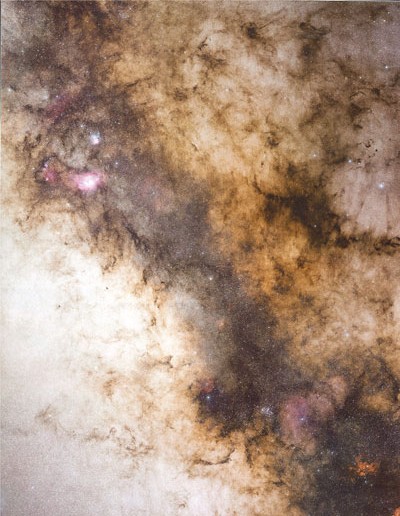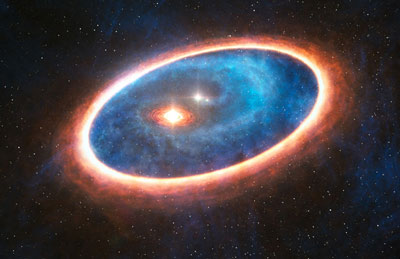                                           
|


 |
Picture Left: Our Milky Way galaxy.
Seen through a large telescope.
The red dots are some of the famous Messier nebulas. They are the birth place for stars.
Our sun is also a star and was once formed in such a nebula
HOW STARS ARE BORN
|
| |
Could the Hunt for Hubble's Constant Overturn the Standard Model of Cosmology?
Space.com October 18, 2017
Cosmology, we have a problem: Two methods that scientists use to measure the expansion of the universe produce different answers, and astronomers aren't quite sure what's going on. A recent episode of NASA's ScienceCasts video series explored this conundrum.
Below:
The shell of a type 1a supernova, shown here, was imaged by the NASA/ESA Hubble Space Telescope's Wide Field Camera 3. Scientists use these types of supernovas to measure the expansion rate of the universe.
Credit: NASA
|
| |
Pence calls for a return to the moon as a stepping stone to Mars
Spaceflight Now October 5 2017
Vice President Mike Pence, chairing a revived National Space Council, said Thursday the United States will once again send astronauts to the moon, using Earth’s satellite as a critical stepping stone for eventual flights to Mars, and vowing to beef up national security space assets to counter rapidly escalating threats from adversaries.
In the human spaceflight arena, Pence said the Trump administration’s space policy calls for sending missions to the moon to test new technologies, to establish infrastructure far beyond low-Earth orbit and to serve as a staging base on the surface, or a gateway in lunar orbit, for robotic and human flights to Mars.
Experts told the panel NASA could return astronauts to the moon within five years using the agency’s huge Space Launch System rocket and Orion crew capsule — and possibly a Saturn 5-class rocket envisioned by SpaceX — to lay the groundwork for landings on the lunar surface or developing an orbital outpost
Below:
Vice President Mike Pence speaks Thursday at the first meeting of the newly-convened National Space Council. Credit: NASA/Joel Kowsky
|
| |
There are a lot of good reasons to be captivated by the exoplanet GJ 1132b. Located in the constellation Vela, it's a mere 39 light-years from Earth — just a hop, skip and a jump in galactic terms. It's similar to Earth in terms of size and mass, and it dances in a close-in orbit around its star, a dimly burning red dwarf.
And, astronomers recently discovered, it has an atmosphere.
The finding, published in the Astronomical Journal, is the first detection of an atmosphere around a terrestrial “Earth-like” planet orbiting a red dwarf star — and it suggests there could be millions more.
Although the researchers call the planet “Earth-like,” the term is only applicable in its broadest sense. GJ 1132b is so close to its sun that it more likely resembles Venus than Earth. Astronomers estimate its average temperature to be about 700 degrees Fahrenheit, and that's without taking into account the potential greenhouse effect of its atmosphere. It is also probably tidally locked, meaning that gravity keeps one side of the planet constantly facing the star, while the other is cast in permanent shadow. GJ 1132b would not make a cozy home for life — at least, not life as we know it.
But the presence of an atmosphere around the exoplanet could have consequences in the search for life on worlds beyond our own, according to lead author John Southworth, an astrophysicist at Keele University in the United Kingdom. Red dwarfs like the one GJ 1132b orbits are the most abundant type of star in the universe, and exoplanet surveys suggest that terrestrial planets around them are also common. If one of them has an atmosphere, then why not more?
“It shows that the huge number of planets in the universe which are like this could have atmospheres themselves and maybe life,” Southworth said.
|
| |
Finally, some details about how NASA actually plans to get to Mars
Ars Technica 29 March 2017
“We are ready to start putting pencils to paper and cutting hardware."
NASA has spent the last six years building the massive Space Launch System rocket, but beyond making general statements about a “Journey to Mars,” the agency has not provided much detail about how the SLS booster would be used to that end. This situation began to change on Tuesday, when the agency’s chief of human spaceflight, Bill Gerstenmaier, briefed the agency’s advisory council on tentative plans for the first dozen launches of the rocket.
During his presentation, Gerstenmaier presented slides outlining the assembly of a “deep space gateway” and subsequent testing of a “deep space transport” system in the vicinity of the Moon. The sequence of missions would culminate in a crewed mission to orbit Mars, but not land, in 2033. Although Gerstenmaier did not identify the funding needed for such a series of events—which would certainly be considerable and require support from the Trump administration—Tuesday’s presentation nonetheless offered an insightful peek into NASA’s future plans.
Below:
The Deep Space Transport shown in cislunar space. Credit NASA
|
| |
NASA Wants to Launch a Giant Magnetic Field to Make Mars Habitable
Science Alert 6 MAR 2017
NASA scientists have proposed a bold plan that could give Mars its atmosphere back and make the Red Planet habitable for future generations of human colonists.
By launching a giant magnetic shield into space to protect Mars from solar winds, the space agency says we could restore the Red Planet's atmosphere, and terraform the Martian environment so that liquid water flows on the surface once again.
Below: Artist impression. Credit NASA
|
| |
TRAPPIST-1 planetary system
NASA telescope reveals largest batch of Earth-size, habitable-zone planets around single star
NASA News | February 22, 2017
NASA's Spitzer Space Telescope has revealed a new exoplanet discovery: the first known system of seven Earth-size planets around a single star. Three of these planets are firmly located in the habitable zone, the area around the parent star where a rocky planet is most likely to have liquid water.
The discovery sets a new record for greatest number of habitable-zone planets found around a single star outside our solar system. All of these seven planets could have liquid water–key to life as we know it–under the right atmospheric conditions, but the chances are highest with the three in the habitable zone.
“This discovery could be a significant piece in the puzzle of finding habitable environments, places that are conducive to life,” said Thomas Zurbuchen, associate administrator of the agency’s Science Mission Directorate in Washington. “Answering the question ‘are we alone’ is a top science priority and finding so many planets like these for the first time in the habitable zone is a remarkable step forward toward that goal.”
At about 40 light-years (235 trillion miles) from Earth, the system of planets is relatively close to us, in the constellation Aquarius. Because they are located outside of our solar system, these planets are scientifically known as exoplanets.
|
| |
Neighbouring star Proxima Centauri has Earth-sized planet
BBC News 24 August 2016
Scientists say their investigations of the closest star, Proxima Centauri, show it to have an Earth-sized planet orbiting about it.
What is more, this rocky globe is moving in a zone that would make liquid water on its surface a possibility.
Below: Location of Proxima Centauri Source: ESO
|
| |
The Telegraph 19 Jun 2015
Extra-terrestrial life does exist, the head of Nasa has confirmed, but said aliens were not hidden in Area 51. Nasa Administrator Major Charles Bolden told British schoolchildren that he was confident that scientists would find life outside of Earth because there were so many planets that are similar to our own. Asked by 10-year-old Carmen Dearing if he believed in aliens, he said: "I do believe that we will someday find other forms of life or a form of life, if not in our solar system then in some of the other solar systems - the billions of solar systems in the universe.
“Today we know that there are literally thousands, if not millions of other planets, many of which may be very similar to our own earth. So some of us, many of us believe that we're going to find...evidence that there is life elsewhere in the universe." Major Bolden also admitted that Area 51 existed but said the US government was not hiding alien life there. More
Below:
On the 14th of June 1975 <Billy> Eduard Albert Meier took more than 70 photographs as well as 8mm film of this Pleiadian space craft at Berg/Rumlikon, Switzerland. Note how the light from the sun is reflecting on the metallic skin of the craft. The craft is piloted by Semjase and she is here performing a demonstration flight for photographic evidence purposes. The craft is 7 meter (23ft) in diameter which also was confirmed through scientific photo analysis by the American investigator team led by Wendelle Stevens. Meier was told they maintained 3 underground bases until 1995, in the area of Switzerland, America and Far East. See Extraterrestrial Bases
Image credit <Billy> Eduard Albert Meier 14. June 1975
|
| |
Stars May Be Forming in Shadow of Milky Way's Monster Black Hole
April 08, 2015
Despite the harsh environment created by the monster black hole lurking in the center of the Milky Way galaxy, new observations show that stars — and, potentially, planets — are forming just two light-years away from the colossal giant.
Below:
The observed and predicted positions of 13 young, massive stars orbiting the supermassive black hole in the center of our galaxy. Credit: Keck/UCLA Galactic Center Group/Cosmus
|
| |
Earth-wide telescope built to watch Milky Way black hole
22 April 2015
Scientists might soon get closer to understanding the nature of the Milky Way’s supermassive black hole. To observe its mysterious event horizon, they are connecting a planet-wide system of telescopes that will “see” 1,000 times better than Hubble.
Below
Credit: Reuters/NASA/JPL-Caltech
|
| |
2008
The black hole in the center of our galaxy was confirmed to exist only in 2008
Black hole confirmed in Milky Way
BBC News 9 December 2008
There is a giant black hole at the centre of our galaxy, a 16-year study by German astronomers has confirmed.
1997
In 1997 Billy Meier published a book where he wrote there is a black hole in the centre of the Milky Way. This was 11 years before it was discovered in 2008.
Aus den Tiefen des Weltenraums… Kontakte mit den Plejadiern/Plejaren (1997) von <Billy> Eduard Albert Meier Page 321. Part Quote:
“…But the scientists will still at that time be prevented from venturing into the centre of our Galaxy, for also to tap into the black hole there. Nor will this be necessary, for the time being, because the surrounding objects are fully sufficient for energy production to suit Earth “
“…, which is why further research will be diligently made, also with regard to Astronomy, whereby it will be penetrated into the centre of the Milky Way in order to fathom the secret of its black hole.”
German original
Unter Bezugnahme auf Aus den Tiefen des Weltenraums… Kontakte mit den Plejadiern/Plejaren (1997) von <Billy> Eduard Albert Meier Seite 321. Teil Zitat:
“Noch wird es aber zu dieser Zeit den Wissenschaftlern verwehrt sein, bis in das Zentrum unserer Galaxie vorzustossen, um auch das dortige Schwarze Loch anzusapfen. Dies aber wird vorderhand auch nicht nötig sein, denn die umliegenden Objekte zur Energiegewinnung sind vollumfänglich ausreichend, um der Erde dienlich zu sein.”
“ …, weshalb fleissig weitergeforscht wird, auch hinsichtlich der Astronomie, wodurch bis in das Zentrum der Milchstrasse vorgedrungen wird, um dessen und des Schwarzen Loches Geheimnis zu ergründen.”
For further reading about what information Billy Meier received about the black hole, see here:
Billy Meier knew the size of the black hole in the Milky Way before the orbit of the star S2 was known.
|
| |
Mars’ vast glacier belts could cover planet with 1 meter of ice – study
April 08, 2015
Mars has been known to host water. Now, for the first time, scientists have measured the territory of its glaciers, which crisscross the planet, hiding beneath layers of dust. It’s enough to cover the whole of the Red Planet in a meter of ice.
(Credit: Mars Digital Image Model, NASA/Nanna Karlsson)
|
| |
Two Earth-like planets could be hiding close to our solar system - and scientists say there may be watery worlds nearby
28 March 2015
• Planets may be close to other habitable worlds 4.3 light years away
• The first planet, dubbed Alpha Centauri Bb, was discovered in 2012
• But it was quickly dismissed by scientists who said it was a false alarm
• New analysis used Hubble data instead to find some signals from the planet, as well as a second
New quantum mechanics theory says parallel universes exist, interact
November 04, 2014
There are three main points to the MIW theory, according to the Griffith statement. First, that the universe we live in is just one of an unknown “gigantic” number of worlds, some of which are “almost identical to ours,” but most are “very different.” Second, all of the worlds are “equally real,” existing continuously through time with precisely defined properties. Third, quantum phenomena arise from “a universal force of repulsion between ‘nearby’ (i.e. similar) worlds, which tends to make them more dissimilar.”
Below:
Image credit Reuter/NRAO
|
| |
The existence of multiple universes comes up frequently in Billy Meier contact notes. In contact 10 with Semjase in 1975 he was told that the universe we see is just one room of many, which must be measured in myriads because there are universes in universes, universes beyond universes, universes below universes, universes above universes and universes outside of universes.
Moreover, Meier was told that the home star and home planet of extra-terrestrial who contacted him are not located in or near the stars of the Pleiades, which can be seen from Earth and as such are present in our space-time configuration, but are instead located beyond these stars a further 80 light away whereby the distance from Earth amounts to about 500 light years. In addition, the stars and planets in the Plejades exists in a dimension that lies a fraction of a second space-and time-shifted in the future to our plane of existence. In this other space-time plane, a star cluster exists with ten different habitable planets…. Billy Meier
|
| |
A Planet With Three Suns?
29 October 2014
Twinkling some 450 light-years away in the constellation Taurus is a complex starry trio known as GG Tau A. Two of the triad’s three stars closely circle one another, like a classic binary pair. But that pair also swings around the third star, creating a turbulent environment that seems like the last place you’d expect to find hints of planet formation.
Except that is exactly what astronomers might be seeing.
Artist’s impression of the three-star system GG Tau Aa. The star GG Tau Aa is the bright object at the centre of the illustration, and the other two stars in the system are on its upper-right side. The outer disc orbiting all three stars can be seen glowing orange, as well as the inner disc surrounding GG Tau Aa. The stream of material is shown in blue and spirals in from the outer disc. (Courtesy: ESO/L Calçada) Source
|
 |
Left:
Artist impression of planet formation in a solar system with three suns
Image credit ESO/L CALcada
|
| |
On the 10th of October 1981 (Contact 150) Billy Meier was told by his extraterrestrial contact that a tristar system existed with 16 inhabited planets. But at that time our science did not believe that such a system with multiple suns could have any planets. Now we know through the latest discoveries that also these type of systems form planets. See my article Bases
Water was flowing on Mars 200,000 years ago – scientists
27 Apr 2014
This latest scientific estimate is interesting as it falls within the time frame Billy Meier claimed Mars was inhabitable. I have put together an article with some of the information which Billy Meier published about Mars: Planet Mars
Scientists find Earth-sized world in orbit friendly to life
April 17, 2014
Below:
NASA's Kepler Space Telescope has discovered the first validated Earth-size planet orbiting in the habitable zone of a distant star, an area where liquid water might exist on its surface. The planet, Kepler-186f, is ten percent larger in size than Earth and orbits its parent star, Kepler-186, every 130 days. The star, located about 500 light-years from Earth, is classified as an M1 dwarf and is half the size and mass of our sun.
|
|
|
|
|
|
|

























































































